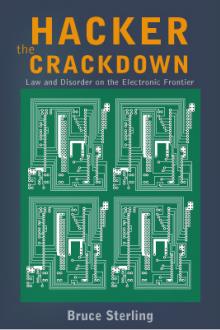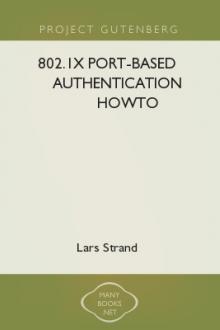Hacker Crackdown by Bruce Sterling (the reader ebook txt) 📖

- Author: Bruce Sterling
- Performer: 055356370X
Book online «Hacker Crackdown by Bruce Sterling (the reader ebook txt) 📖». Author Bruce Sterling
Charles Boykin, a veteran AT&T hardware and digital communications expert, was a local technical backup man for the AT&T 3B2 system. As a display model in the Infomart mall, “Killer” had little to do, and it seemed a shame to waste the system’s capacity. So Boykin ingeniously wrote some UNIX bulletin-board software for “Killer,” and plugged the machine in to the local phone network. “Killer’s” debut in late 1985 made it the first publicly available UNIX site in the state of Texas. Anyone who wanted to play was welcome.
The machine immediately attracted an electronic community. It joined the UUCP network, and offered network links to over eighty other computer sites, all of which became dependent on Killer for their links to the greater world of cyberspace. And it wasn’t just for the big guys; personal computer users also stored freeware programs for the Amiga, the Apple, the IBM and the Macintosh on Killer’s vast 3,200 meg archives. At one time, Killer had the largest library of public-domain Macintosh software in Texas.
Eventually, Killer attracted about 1,500 users, all busily communicating, uploading and downloading, getting mail, gossipping, and linking to arcane and distant networks.
Boykin received no pay for running Killer. He considered it good publicity for the AT&T 3B2 system (whose sales were somewhat less than stellar), but he also simply enjoyed the vibrant community his skill had created. He gave away the bulletin-board UNIX software he had written, free of charge.
In the UNIX programming community, Charlie Boykin had the reputation of a warm, open-hearted, level-headed kind of guy. In 1989, a group of Texan UNIX professionals voted Boykin “System Administrator of the Year.” He was considered a fellow you could trust for good advice.
In September 1988, without warning, the E911 Document came plunging into Boykin’s life, forwarded by Richard Andrews. Boykin immediately recognized that the Document was hot property. He was not a voice-communications man, and knew little about the ins and outs of the Baby Bells, but he certainly knew what the 911 System was, and he was angry to see confidential data about it in the hands of a nogoodnik. This was clearly a matter for telco security. So, on September 21, 1988, Boykin made yet ANOTHER copy of the E911 Document and passed this one along to a professional acquaintance of his, one Jerome Dalton, from AT&T Corporate Information Security. Jerry Dalton was the very fellow who would later raid Terminus’s house.
From AT&T’s security division, the E911 Document went to Bellcore.
Bellcore (or BELL COmmunications REsearch) had once been the central laboratory of the Bell System. Bell Labs employees had invented the UNIX operating system. Now Bellcore was a quasi-independent, jointly owned company that acted as the research arm for all seven of the Baby Bell RBOCs. Bellcore was in a good position to coordinate security technology and consultation for the RBOCs, and the gentleman in charge of this effort was Henry M. Kluepfel, a veteran of the Bell System who had worked there for twenty-four years.
On October 13, 1988, Dalton passed the E911 Document to Henry Kluepfel. Kluepfel, a veteran expert witness in telecommunications fraud and computer-fraud cases, had certainly seen worse trouble than this. He recognized the document for what it was: a trophy from a hacker breakin.
However, whatever harm had been done in the intrusion was presumably old news. At this point there seemed little to be done. Kluepfel made a careful note of the circumstances and shelved the problem for the time being.
Whole months passed.
February 1989 arrived. The Atlanta Three were living it up in Bell South’s switches, and had not yet met their comeuppance. The Legion was thriving. So was PHRACK magazine. A good six months had passed since Prophet’s AIMSX breakin. Prophet, as hackers will, grew weary of sitting on his laurels. “Knight Lightning” and “Taran King,” the editors of PHRACK, were always begging Prophet for material they could publish. Prophet decided that the heat must be off by this time, and that he could safely brag, boast, and strut.
So he sent a copy of the E911 Document—yet another one— from Rich Andrews’ Jolnet machine to Knight Lightning’s BITnet account at the University of Missouri.
Let’s review the fate of the document so far.
0. The original E911 Document. This in the AIMSX system on a mainframe computer in Atlanta, available to hundreds of people, but all of them, presumably, BellSouth employees. An unknown number of them may have their own copies of this document, but they are all professionals and all trusted by the phone company.
1. Prophet’s illicit copy, at home on his own computer in Decatur, Georgia.
2. Prophet’s back-up copy, stored on Rich Andrew’s Jolnet machine in the basement of Rich Andrews’ house near Joliet Illinois.
3. Charles Boykin’s copy on “Killer” in Dallas, Texas, sent by Rich Andrews from Joliet.
4. Jerry Dalton’s copy at AT&T Corporate Information Security in New Jersey, sent from Charles Boykin in Dallas.
5. Henry Kluepfel’s copy at Bellcore security headquarters in New Jersey, sent by Dalton.
6. Knight Lightning’s copy, sent by Prophet from Rich Andrews’ machine, and now in Columbia, Missouri.
We can see that the “security” situation of this proprietary document, once dug out of AIMSX, swiftly became bizarre. Without any money changing hands, without any particular special effort, this data had been reproduced at least six times and had spread itself all over the continent. By far the worst, however, was yet to come.
In February 1989, Prophet and Knight Lightning bargained electronically over the fate of this trophy. Prophet wanted to boast, but, at the same time, scarcely wanted to be caught.
For his part, Knight Lightning was eager to publish as much of the document as he could manage. Knight Lightning was a fledgling political-science major with a particular interest in freedom-of-information issues. He would gladly publish most anything that would reflect glory on the prowess of the underground and embarrass the telcos. However, Knight Lightning himself had contacts in telco security, and sometimes consulted them on material he’d received that might be too dicey for publication.
Prophet and Knight Lightning decided to edit the E911 Document so as to delete most of its identifying traits. First of all, its large “NOT FOR USE OR DISCLOSURE” warning had to go. Then there were other matters. For instance, it listed the office telephone numbers of several BellSouth 911 specialists in Florida. If these phone numbers were published in PHRACK, the BellSouth employees involved would very likely be hassled by phone phreaks, which would anger BellSouth no end, and pose a definite operational hazard for both Prophet and PHRACK.
So Knight Lightning cut the Document almost in half, removing the phone numbers and some of the touchier and more specific information. He passed it back electronically to Prophet; Prophet was still nervous, so Knight Lightning cut a bit more. They finally agreed that it was ready to go, and that it would be published in PHRACK under the pseudonym, “The Eavesdropper.”
And this was done on February 25, 1989.
The twenty-fourth issue of PHRACK featured a chatty interview with co-ed phone-phreak “Chanda Leir,” three articles on BITNET and its links to other computer networks, an article on 800 and 900 numbers by “Unknown User,” “VaxCat’s” article on telco basics (slyly entitled “Lifting Ma Bell’s Veil of Secrecy,)” and the usual “Phrack World News.”
The News section, with painful irony, featured an extended account of the sentencing of “Shadowhawk,” an eighteen-year-old Chicago hacker who had just been put in federal prison by William J. Cook himself.
And then there were the two articles by “The Eavesdropper.” The first was the edited E911 Document, now titled “Control Office Administration Of Enhanced 911 Services for Special Services and Major Account Centers.” Eavesdropper’s second article was a glossary of terms explaining the blizzard of telco acronyms and buzzwords in the E911 Document.
The hapless document was now distributed, in the usual PHRACK routine, to a good one hundred and fifty sites. Not a hundred and fifty PEOPLE, mind you—a hundred and fifty SITES, some of these sites linked to UNIX nodes or bulletin board systems, which themselves had readerships of tens, dozens, even hundreds of people.
This was February 1989. Nothing happened immediately. Summer came, and the Atlanta crew were raided by the Secret Service. Fry Guy was apprehended. Still nothing whatever happened to PHRACK. Six more issues of PHRACK came out, 30 in all, more or less on a monthly schedule. Knight Lightning and co-editor Taran King went untouched.
PHRACK tended to duck and cover whenever the heat came down. During the summer busts of 1987—(hacker busts tended to cluster in summer, perhaps because hackers were easier to find at home than in college)—PHRACK had ceased publication for several months, and laid low. Several LoD hangers-on had been arrested, but nothing had happened to the PHRACK crew, the premiere gossips of the underground. In 1988, PHRACK had been taken over by a new editor, “Crimson Death,” a raucous youngster with a taste for anarchy files.
1989, however, looked like a bounty year for the underground. Knight Lightning and his co-editor Taran King took up the reins again, and PHRACK flourished throughout 1989. Atlanta LoD went down hard in the summer of 1989, but PHRACK rolled merrily on. Prophet’s E911 Document seemed unlikely to cause PHRACK any trouble. By January 1990, it had been available in PHRACK for almost a year. Kluepfel and Dalton, officers of Bellcore and AT&T security, had possessed the document for sixteen months—in fact, they’d had it even before Knight Lightning himself, and had done nothing in particular to stop its distribution. They hadn’t even told Rich Andrews or Charles Boykin to erase the copies from their UNIX nodes, Jolnet and Killer.
But then came the monster Martin Luther King Day Crash of January 15, 1990.
A flat three days later, on January 18, four agents showed up at Knight Lightning’s fraternity house. One was Timothy Foley, the second Barbara Golden, both of them Secret Service agents from the Chicago office. Also along was a University of Missouri security officer, and Reed Newlin, a security man from Southwestern Bell, the RBOC having jurisdiction over Missouri.
Foley accused Knight Lightning of causing the nationwide crash of the phone system.
Knight Lightning was aghast at this allegation. On the face of it, the suspicion was not entirely implausible—though Knight Lightning knew that he himself hadn’t done it. Plenty of hot-dog hackers had bragged that they could crash the phone system, however. “Shadowhawk,” for instance, the Chicago hacker whom William Cook had recently put in jail, had several times boasted on boards that he could “shut down AT&T’s public switched network.”
And now this event, or something that looked just like it, had actually taken place. The Crash had lit a fire under the Chicago Task Force. And the former fence-sitters at Bellcore and AT&T were now ready to roll. The consensus among telco security—already horrified by the skill of the BellSouth intruders—was that the digital underground was out of hand. LoD and PHRACK must go.
And in publishing Prophet’s E911 Document, PHRACK had provided law enforcement with what appeared to be a powerful legal weapon.
Foley confronted Knight Lightning about the E911 Document.
Knight Lightning was cowed. He immediately began “cooperating fully” in the usual tradition of the digital





Comments (0)